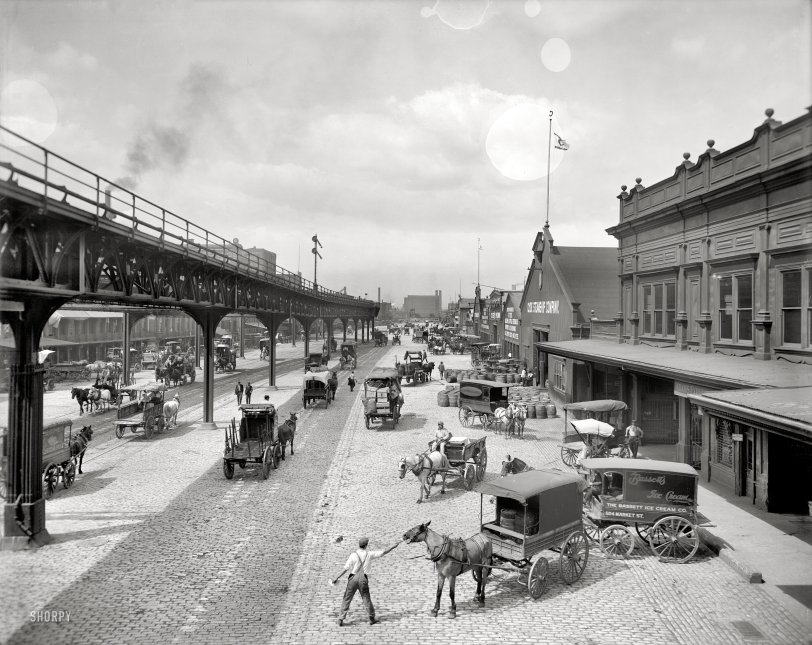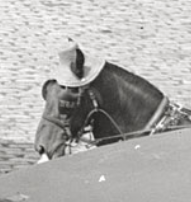


Framed or unframed, desk size to sofa size, printed by us in Arizona and Alabama since 2007. Explore now.
Shorpy is funded by you. Patreon contributors get an ad-free experience.
Learn more.

- I remember it well
- I can't prove it
- Complicated then, forgotten now
- Bryan-Stevenson
- Skinny is as skinny does
- How do you rest in peace
- Riding the footboards
- Alas, hidden from view
- Baldwin Diesels
- Exclusive pump
- Bananas, Oysters and Smokey Joe
- Details, Details
- What's that building to the left of the tower?
- Coal Barges
- Bromo-Seltzer
- Inner harbor
- The Basin
- What a headache!
- Giant stepladder?
- Yeah, it was cold
- Love those coats
- Link & Pin Days Remnant
- Baldwin 62303
- Baldwin VO-1000
- Cold
- No expense spared
- Tough Guys
- What's your hurry, where's your hat?
- Sheriff's Signature
- Relocated in the Eighties
Print Emporium
Old Philly: 1908

Philadelphia circa 1908. "Delaware Avenue, foot of Market Street." 8x10 inch dry plate glass negative, Detroit Publishing Company. View full size.
Men in Hats
Not just for horses. All the men are sporting a variety of hats from straw boaters to caps. I like the boater on the man to the right pushing a handcart. Harry Kyriakodis has a book on the Philadelphia waterfront full of interesting info. My ancestor had a sailmaking loft on Del Ave in the 1890s McGinnis & Fitzgerald.
Shadow curve
As has been noted, the El originally terminated at the ferries to Camden, with the elevated track doing a 180 degree turn before going into the subway. This curve can be seen in shadow at image left. The track continues behind and left of the camera, terminating at South Street. This branch stayed in operation into the 1940s.
Disgruntled equine
Saw the hat and wants one. Not moving till he gets one like his friend has.
Stony Ballast
I grew up in Philadelphia and lived in the Frankford neighborhood when I went to college. I believe this elevated "stub" became part of the Frankford Elevated which was completed about 1925 and connects to the Market St subway. I rode the El everyday for several years.
The cobbletones are said to have come from Europe as ballast in sailing ships. The primary cargo flow was natural resources from America to Europe and ballast was needed for ship stability on the trip from Europe to America. No idea how they were originally made.
A lot of cobbletone areas remain in Phila, they serve to keep traffic speeds down.
Cobblestones
Ships from the New World crossed the Atlantic laden with goods for trade. Most ships required ballast when they made the return crossing because they didn't bring equal tonnage back with them. The off-loaded ballast stones became paving stones for Philadelphia's early streets.
Laying Paving Stones
I watched a guy laying paving stones by hand outside the main train station in Pisa, Italy in 1987. He would pick up a stone, put it into place, and set it with one hit from a mallet. Although he was laying a curved pattern he could set up about 1 stone every 4 to 5 seconds. It was amazing how fast he could lay them.
A quick count shows there are about 3 x 7 stones in an area about 1 square yard (I counted the stones around the manhole cover which is probably about 36 inches across). The square is about 40 yards wide and say 600 yards long in the picture (I'm lousy at estimating distance, so pick your own numbers). That's 24,000 square yards or about 500,000 paving stones. At 12 stones/minute (my Italian guy) that's 70 man-days (10 hour days) to lay this many stones. So a team of 10 guys could do it in a week, if each had a helper to fetch stones.
Of course you have to prepare the ground, haul the stones, etc. Still with less than 50 people it wouldn't take more than a summer to do.
That's just a back of an envelope calculation, but it's not hard to see that in a city of this size, the labor to make it happen could easily be hired.
This is the best!
I adore this photo! So much activity here and it is a visual feast. Thank you Dave. More please?
Stones in the Road
What intrigues me the most about this and many other old photos is the cobblestone streets. There must have been billions of stones. Where were they produced? How long did it take to pave a given area?
Stone Age
Man, that's a lot of paving stone! All of them laid by hand. What a backbreaking job! I'm guessing they just paved over them, as they did here in NYC.
Only John Wanamker
The fanciest rig in the scene, drawn by a pair of white horses, is from Wanamaker's department store. No Philadelphian would have expected it to be otherwise.
My grandfather drove deliveries for Lit Brothers, a good department store but a few rungs below Wanamaker's (Strawbridge & Clothier was also below Wanamaker but above Lits*). He bore the mark of a horse kick he sustained on the job for the rest of his life.
*Gimbel's operated a store in Philadelphia but they were from New York, ninety-six rail miles from the center of everything, so they can't be properly placed within this spectrum.
Horses do have hats!
Personal pet dress up or some other reason?

I wonder who won
the man or the horse at the bootum of the picture. Just above that wagon is a horse with a nice chapeau.
That Thar horse
a pullin' that ice cream wagon is wearing a chapeau
Bassett's Ice Cream
Still in business at (and one of the original merchants still in) the Reading Terminal Market.
Tug a little harder
Looks like ol' Bessie doesn't want to go!
My Great Grandparents' World
Great image of the area where my great-grandparents lived and my grandfather was born (Chestnut and 5th in 1905).
Thank you, Dave, for all the wonderful images of Philly.
Tags
- Adams Express
- Borax Soap
- Clyde Steamship Company
- Philadelphia, New York, Paris
- The Bassett Ice Cream Co., 504 Market St.
- Toasted Corn Flakes
Four-Legged Drive
Perhaps the driver at the bottom center is having difficulty shifting his commercial vehicle from the "idle" position.
Breakfast Time
Boy, I feel like some Toasted Corn Flakes. If only they'd "fall off the back of a truck."
Frustration
I wouldn't know what would be worse, a stubborn car or a stubborn horse. What a great photo.
Finally
A horse with a hat! Terrific vignette of a vibrant commercial centre. So much to see and enjoy.
Horselessless
Gee, not a horseless carriage in sight.
Mad Hatter
Check out the horse with a straw hat on the bottom right hand corner. Doesn't look like protective gear but an actual straw hat with ear holes! Too cute.
Pain In The Ass
That fellow in the foreground seems to be having trouble motivating his mule.
Paved over
All of this is torn down and paved over today. But you can find some interesting things on the history of the area. Pier 3 Condominiums, for example, has collected a lot of information about the old waterfront.
Among the details is a reference to an elevated railway connecting to the Market Street Subway:
"completed on Delaware Avenue from Arch to South Streets in 1908. This route was known as the Delaware Avenue El or the Ferry Line, since its stops served the various ferries to New Jersey. There were two stops, one at Market-Chestnut and one at South Street where the line stub-ended."
This looks like the "stub end."
You can lose yourself in this picture
I love these photos, lots to see. An ice cream wagon, a horse wearing a hat. A reluctant horse, borax soap and a huge box of corn flakes. And I'm just getting started.
Horse with a hat.
I love the Horse with a hat. The guy in the buggy must had loved his horse. It's next to the Bassett Ice Cream wagon. What a priceless photo.
Mad Hatter
I love how this horse has a straw hat on!
Lens Flares!
OK - Did these guys pose or was the shutter speed that fast?
Aside from the historical interest
... this is just a fantastic composition.
Employee/management issue
Man and horse seem to disagree about something. The horse is probably not happy with his benefits package and 401K.
























On Shorpy:
Today’s Top 5